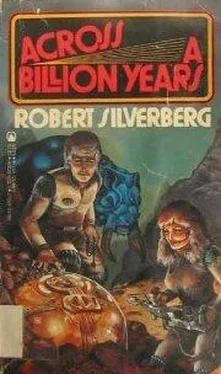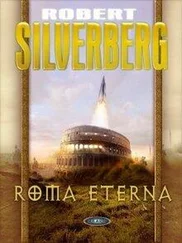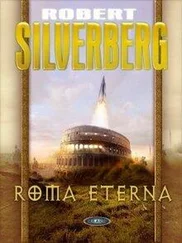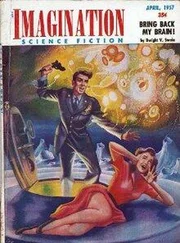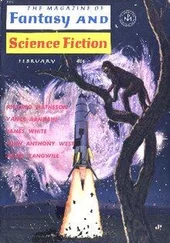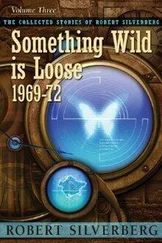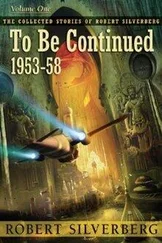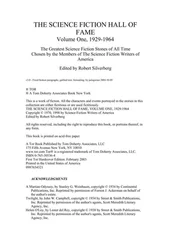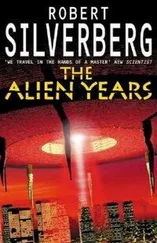“But he wasn’t crushing back.”
“Whenever I started getting the least bit biological he’d hide behind a stamp album.”
“Poor Saul,” I said,
“Finally I saw that it was hopeless. And then I started going with you.”
“Except you went back to Saul after we left Higby V.”
“That was only to make you jealous,” Jan said. “To get even with you for fissioning around with Kelly.”
“But I wasn’t—”
“It didn’t look that way.”
“Evil’s in the eye of the beholder. Old—”
“—Paradoxian proverb. I know,” she said. “Well, you could have explained a lot earlier that there was nothing going on between you and Kelly, and saved me two weeks of stamp albums.”
“But I didn’t know that that was what you had against me. Why didn’t you tell me?”
“And look like a jealous little minx?”
“But—”
“But—”
“If you had only said—”
“If you had only said—”
“Gabbling blenker!”
“Spinless feeb!”
“!”
“!!”
We broke up in laughter. I threw some more snow at her. She threw some more at me. We raced toward the ship. The hatch of the airlock closed behind us and we got our helmets off fast.…
Why do women have to be like that, Lorie?
Why can’t they come right out and say what’s bothering them? If Jan hadn’t imagined all sorts of dire stuff going on between Kelly and me, and hadn’t staged this deal with Saul to get even with me for my imaginary sins, we wouldn’t have wasted all this time and given each other two dreary weeks.
Sometimes I think the Calamorians have the right idea. Putting both sexes in one body with a single brain eliminates these messy communications problems. If Steen Steen ever gets into a lovers’ spat with him/herself, he/she has nobody to blame for the mix-up but him/herself. I mean — oh, blot it. You know.
* * *
December 20
We have twenty-one asteroids on our list now. We blast off after lunch to begin searching them for the robot vault.
TWELVE
Merry Christmas
In the Asteroid Belt
Once you’ve seen one asteroid belt, you’ve seen them all. The one we’re in doesn’t differ much from that of our home system: thousands of planet-fragments moving in a maze of orbits. Most of them are irregular chunks of rock a few kilometers in diameter, or less. (We saw one of those that looked exactly like a broken-off mountaintop. Perhaps it was.) But the ones we’re exploring for the vault are much larger than that, good-sized little worlds with diameters of 100 to 180 kilometers. Gravitational stresses operating on an asteroid of such a size wear down any projecting corners and force the asteroid to assume the normal spherical shape of a heavenly body.
We’ve toured eight of our twenty-one asteroids so far. No luck.
We use a two-stage scouting technique. First we put our ship in orbit around the asteroid we’re checking; as we swing around it, we bounce a sonar probe off it to locate large cavities close to the surface. Our instruments are sensitive enough so that a cave the size of the High Ones vault would show up. If anything registers, two of us then go down in landing pods for a closer look.
Most of these asteroids, being pieces of a shattered world, are solid throughout — no underground cavities of the proper size or position. (The High Ones built their vault in the side of a hill, remember. Since there’s no erosion on a planet or asteroid that lacks an atmosphere, and no internal volcanic action on a place this small, that hill ought still to look the way it did a billion years ago.)
We’ve made three landing-pod drops so far, a false alarm each time. The very first asteroid we checked seemed to have a cave in just the right position, which we thought was too good to be true. It was. Pilazinool and Kelly made the drop, and when Kelly cored into the hillside she found that there wasn’t any cave, just a big salt deposit within the hill; we had misinterpreted our sonar data. Three asteroids later, Saul and Steen made the drop, but discovered that the cave was a natural one. And on the seventh asteroid Leroy Chang and Dr. Schein went down, only to find that we had misread our probe again; what we thought was a hole in the ground turned out to be a huge pool of mercury, no less.
That wasn’t a bad misreading. Captain Ludwig immediately hopped into a pod and went down to inspect.
“You’ve got a million credits’ worth of quicksilver out there,” he reported. “Never saw the stuff frozen solid before, but there it is. You be smart, slap a mining claim on it fast.”
We didn’t know much about mining claims, but Ludwig did, and we gleefully let him show us the procedure. Stash is stash, after all. We radioed our claim to the nearest galactic message depot, 2.8 light-years away, setting forth the coordinates of this asteroid and filing notice of discovery of the mine. It will, naturally, take close to three years for our message to reach the depot and be recorded, but at least we have established incontrovertible proof of our filing the claim on December 22, 2375. Meanwhile, as soon as we leave here and come to a planet that has a TP communications office, we’ll notify Galaxy Central by TP of the discovery, and make the claim official. It may be six months or even more before we have a chance to do that; but in the unlikely event that somebody else comes here between now and then, finds the mine, and hustles off instantly to file a claim by TP, we’ll merely have to wait until our radio message comes floating into the depot three years from now to demonstrate our prior discovery. There’s no way to fake that kind of claim: it takes 2.8 years for a radio message to travel 2.8 light-years, and once our claim is in, no one can possibly jump it.
We’re cutting Ludwig in for 10 percent of the profits, and his sidekick Webber Fileclerk for 5 percent. That’ll make them both a lot richer than they ever would have become as charter pilots. The rest of the stash goes to us, not as individuals but as an expedition; it’ll be used to pay off the monstrous deficit we’ve run up. Galaxy Central can no longer accuse us of fraud, embezzlement, exceeding of budget, or other dire things.
We’d still like to find that High Ones vault, though.
* * *
December 27
Two days more have gone by. We’ve checked three additional asteroids, and we’ve found another possible site for the vault. Jan and I are going to make the drop in about half an hour.
Nick Ludwig is programming the entry orbits for the landing pods. Webber Fileclerk is fueling them. The rest of us are sitting around nervously, wondering — for the fourth time — if this is it. Another ten minutes and Jan and I will be getting into our breathing-suits. Twenty minutes and we climb into the landing pods. Thirty minutes and down we go. I’ve got that sense of an overture playing again — the curtain about to rise —
* * *
By zog, we found it!
No, that’s no way to tell it, not with wild whoops and jubilations. Let me be more matter-of-fact, more mature. Let me tell it calmly, step by step, from the moment we got into our landing pods.
Landing pods —
A landing pod is essentially a miniature spaceship, designed for work in a low-gravity region, such as an asteroid belt. It’s a cigar-shaped tube about five meters long and two meters wide at its widest point; thus it can hold only one passenger, who must remain standing throughout the voyage. Mirrik is disqualified from using the pods because of his bulk; Dr. Horkkk is too short, unable to reach some of the controls, and 408b is the wrong shape, being wider than it is tall, to fit inside. That leaves eight of us able to go down to explore the asteroids in pods; and it’s just the luck of the draw that Jan and I were the fourth team to go.
Читать дальше
